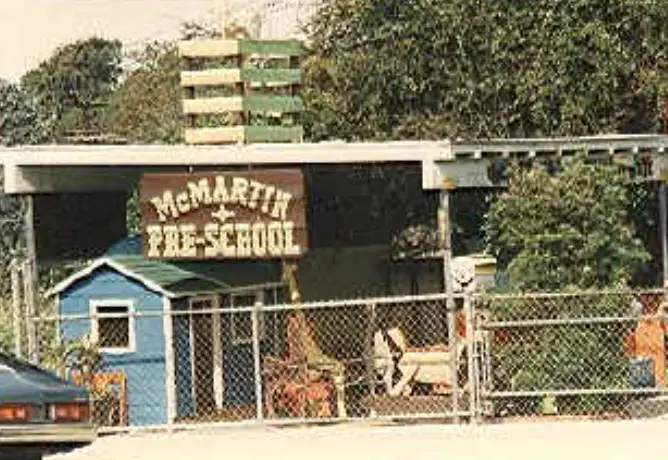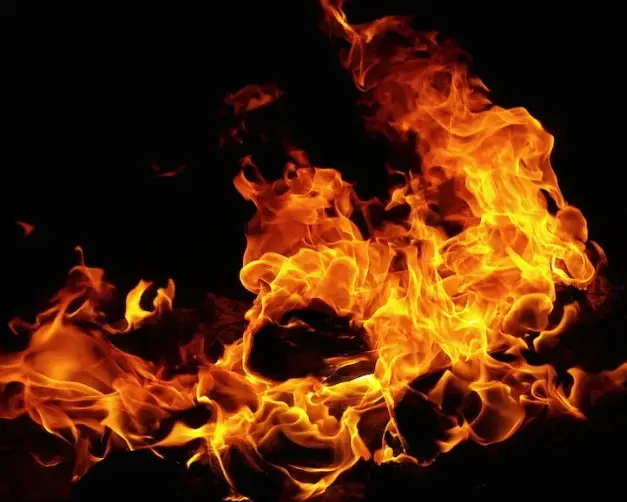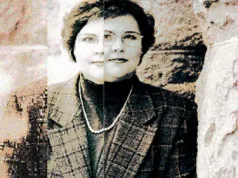Satanic Ritual Abuse refers to supposed cases where an organisation, group, religion or any other entity engage in practices that revolve around worshipping the devil.
In the 1980s and 1990s, there was widespread panic and huge media interest due to a rise in cases reputedly involving satanic ritual abuse.
It was believed widescale abuse was happening in regular, everyday locations. Needless to say, this was a controversial moment in time. It is also closely related to the subject of Recovered Memory – which itself is a highly-controversial subject.

What is Satanic Ritual Abuse?
The term ‘satanic ritual abuse’ refers to an instance where a victim (or often many victims) is abused over an extended period of time.
A person is abused both physically and mentally, and may include torture, the killing of others, exorcisms, sacrifices, cannibalism and engaging in satanic rituals. A person is generally indoctrinated into a way of thinking, which may involve brainwashing.
Often, this form of abuse takes place within a group, and a certain ideology is taught. This ideology usually attempts to justify the actions.
The group usually attempt to stay off the radar, and are usually secretive. Many would consider these groups a cult. Social groups, schools and other groups may all feasibly involve widescale abuses.
Satanic ritual abuse can take place anywhere, and despite its name – is not limited to satanic-worshipping organisations. It can be perpetrated by anyone – including men and women of all ages. Often, ritual abuse may take place in a setting where no one would expect. All ritual abuse too is not necessarily satanic.
While media sensationalising led to claims that satanic ritual abuse was nothing but a hoax, this is incorrect. Satanic ritual abuse was, and continues to be, a very big problem.
An original report that was commissioned by the FBI found there to be no ‘substantive evidence’ that suggested ritual abuse existed [1]. It has also been dismissed as a ‘modern-day witch hunt’, and a ‘conspiracy theory’ [2]. But many convictions have been recorded, and hundreds of allegations made.
Recovered Memories and Satanic Ritual Abuse
Many cases involving alleged satanic ritual abuse featured memories that had been ‘recovered’ during therapy sessions. There is significant controversy about this though.
In general, a person with mental distress would seek the help of a professional, who may suspect there was a history of abuse in their childhood.
Many cases involved a person who seemingly had dissociative identity disorder, or multiple personality disorder as it was known. Some believed alter egos of a person resembled a satanic deity.
Proponents of recovered memory suggest that a person can repress traumas into the unconscious mind – so that they forget all about the past. But this trauma will continue to affect an individual into the present day.
Therefore, during the 1980s and 1990s, therapy aimed at uncovering these memories was commonplace. Moreover, many people with dissociative identity disorder also suffer post-traumatic stress disorder – which could be linked to such events [3].
Therapy often involved unconventional methods to try and uncover the supposed traumas. Hypnosis, so-called ‘truth serums’ and guided imagery were all commonly used.
It resulted in many memories being supposedly “recovered” – but it was never clear if these memories were authentic, or had instead been implanted by a therapist inadvertently.
Satanic Ritual abuse can cause a plethora of problems – mainly psychological distress. Years of abuse can lead to someone being traumatised, and they would likely suffer from post-traumatic stress disorder, and/or more conditions. They may often have flashbacks, or lose awareness for a space of time – known as dissociation.
A part of the problem with satanic ritual abuse is that seemingly very few people believe a victim. The victim’s story is normally seen as farfetched and unlikely. Due to their lack of credibility, allegations often go unchecked.
In the modern day, recovered memories are treated with caution, and are generally inadmissible in court without corroboration from elsewhere. But this was not the case at all in the 1980s.
Growing issues
In the early 1980s, a few cases involving alleged abuse of children in day-care centres and pre-schools started being reported on.
The most infamous case was the McMartin preschool abuse case. This resulted in the media getting into a frenzy when reporting on the case.
A mass hysteria followed, with hundreds of cases being reported, and widespread panic among parents of the idea that Satanists were integrating in society, abusing their children.
What didn’t help is that many adults who sought treatment also alleged they had been abused in their childhood – aided by the aforementioned practice of trying to uncover past memories.
The McMartin case generated enormous publicity, and led to worries regarding just how many pre-schools or schools were engaging in abuse. It is worth mentioning that the McMartin abuse case ended in no convictions, albeit after several years of criminal proceedings.
Rumours spread like wildfire within local areas, and many cases of what seemed to be sexual abuse, soon turned into satanic ritual abuse.
The media continued to sensationalise events, and huge swathes of people started to suspect their child had been abused. Marches took place, and at times it seemed that crowds were baying for blood.
The hysteria was also fuelled by psychotherapists, who were the ones in many cases pushing a person to “recover” past memories.
Social workers and the Police were also criticised, with inadequate investigations being carried out. The Police were heavily criticised for seemingly losing control of many cases.
Famous Cases
Soon enough, high-profile cases appeared, all of which were linked to ritual abuse – often Satanic in their nature. In total, cases featuring ritual abuse totalled hundreds. Here, we take a look at three high-profile cases:
McMartin Preschool Abuse Trial: As mentioned above, this is regarded as the most infamous case in this subject area. In 1984, almost 300 children said in interviews that they had been abused by staff at the school, alluding to a network of secret tunnels that led to areas where abuse was carried out. Seven people were arrested, though just 2 went to trial. The interviews used dubious strategies, and resulted in the interviewers believing that those interviewed had been abused. The validity of the interviews was questioned by defence lawyers. At the end of the trial, 1 person was acquitted with the jury deadlocked on the other defendant. A second trial resulted in a mistrial, and the defendant was freed. After seven years and $15million used to fund the case, no convictions were made. It is unknown if there was abuse at all at the school. No tunnels were found amid mass excavating.
Kern County Satanic Cult: A range of cases in Kern County, California took place. Dozens of people from around the county were arrested, with many convictions. Most of the evidence in the different cases came from testimonies from the children that had been allegedly abused. Many of the convictions were later overturned, and significant compensation was awarded to many different people. Some of those who were awaiting trials for appeals died in prison before the trials. It is believed many of these cases were false, and that many innocent people may have been imprisoned.
Jordan, Minnesota Abuse Case: In 1983 several children made allegations about being abused. A person was arrested, and confessed to the crimes. Other parents were suspected as co-conspirators, and 24 people in total were arrested. The mother who had made the original allegation was among those arrested. It was believed that sex parties were being held in the town, with incest, bestiality and sadism all commonplace. Only 3 of the several arrested made it to trial. A trial took place, and defence witnesses were able to pick holes in the accounts of children who had reputedly been abused. The jury cleared the trio of any wrongdoing, though questions remain. The Police’s investigation was criticised as being flawed, and it is believed many abusers never faced justice due to the poor investigations.
Rochdale, England Case: In 1990, newspapers in the United Kingdom went into a frenzy following allegations of satanic ritual abuse in the northern town of Rochdale. A parent of a 6-year old child told how her son was telling stories about babies being killed and black magic. This sole accusation led to 17 children being suddenly taken away from their parents by social workers – on the orders of the police. Parents of the children taken away were questioned, with social workers concluding that the children had been victims of a satanic cult. But overzealous reporting, coupled with flimsy evidence, showed how the hysteria around satanic abuse had affected the world. All cases were dropped, and the children were returned to their parents.
The Truth
With major investigations being carried out into a huge array of cases, eventually there was very little evidence to suggest widescale satanic cults were masquerading under the guise of everyday organisations, pre-school or day-care centres.
A small amount of cases did appear to be linked to ritual abuse, but they were certainly in the minority. The mass hysteria contributed to all of the wild accusations.
There were multiple lawsuits filed for multiple reasons. Many of those accused of abuse through “recovered” memories sued therapists and medical centres – with the case of Gary Ramona being the first of this type. Across the world, huge pay-outs were given as compensation due to the mass negligence.
As the 1990s came to an end, interest in the supposed satanic cults waned. The topic of recovered memories however continues to be discussed to this day, and generates significant controversy.
Summary
There is no doubting that secretive satanic cults do exist. In the past, these groups have abused many individuals, and have caused significant emotional distress.
But the 1980s and 1990s – which became something of an epidemic – saw allegations get out of control. It is also very likely that actual cases of abuse were drowned out amidst the widespread panic.
While many cases resulted in justice being served, many innocent people ended up in jail. Even to this day, many questions are being asked regarding allegations made, and whether or not they were truthful. At the very least, this hysteria did cause many, many lessons to be learned [4].
VISIT OUR RECOVERED MEMORY BLOG
Disclaimer
This website should be used purely for informational purposes, and does not intend to, nor should it ever, be used as a replacement for professional medical advice.
We strive to keep all of our pages updated, and ensure that our website is full of factual and in-depth information. However, we encourage you to browse this website with care.
As a reminder, this website and all content within it cannot and should not replace the advice of a trained medical professional. You can read our full disclaimer at this link.
Helplines
If you are struggling with your mental health, help is available. With the right support and treatment, you can make a recovery. For information on helplines, or if you are in a state of crisis, please visit our crisis page by clicking on the relevant link for your geographical location (United Kingdom), (United States), (International). You can also see how to get mental health treatment and the process involved by clicking this link.
References
1] Lanning, K.V. (1991). Ritual abuse: A law enforcement view or perspective. Child Abuse & Neglect. 15 (3): p171-173.
2] Victor, J. (1992). Ritual Abuse and the Moral Crusade against Satanism. Journal of Psychology and Theology. 20 (3): p248-253.
3] Bottoms, B., Shaver, P. & Goodman, G. (1996). An analysis of ritualistic and religion-related child abuse allegations. Law and Human Behavior. 20 (1): p1-34.
4] Wood, J., Nezworski, M., Nathan, D. & Uhl, E. (2009). Child sexual abuse investigations: Lessons learned from the McMartin and other daycare cases. In: Bottoms, B., Najdowski, C. & Goodman, G Children as Victims, Witnesses, and Offenders: Psychological Science and the Law. New York: Guildford Press. p81-101.



































